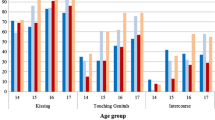Abstract
The purposes of this descriptive study are to survey and compare the following criteria: estimated prevalence of sexual problems, the development of love, and attitudes toward sexuality between persons with and without disabilities. The sample was 25 persons with disabilities and 76 persons without disabilities. The questionnaires consisted of 35 questions and were distributed to the sample. Research results showed that sexual problems occurred in 36% of persons with disabilities and in 12% of persons without. Both samples were not significantly different as to the kinds of love they want. In contrast, both samples are significantly different in their consideration for selecting lovers. Most attitudes toward sexuality between persons with and without disabilities were not significantly different. This is a good sign since it implies that there are more opportunities and possibilities for persons with and without disabilities to establish love, to form attachment, and to marry if sexual education and appropriate sexual communication are facilitated.
Similar content being viewed by others
REFERENCES
Corey G: Theory and practice of counseling and psychotherapy. California: Brooks and Cole Publishing Company Pacific Grove, 1991, pp. 96-97.
Hayes HJ, et al: Transitioning individuals with mental retardation and developmental disability: the other sister. Journal of the American Academy of Psychiatry and the Law 28(2): 202-205, 2000.
Anderson P, Kitchin R: Disability, space, and sexuality: access to family planing services. Social Science and Medicine 51(8): 1663-1173, 2000.
Earle S: Facilitated sex and the concept of sexual need: disabled students and their personal assistants. Disability and Society 14(3): 309-323, 1999.
Scorzelli FJ: Sexuality and disability. Manuscript in preparation, 1993.
Block P: Sexuality, fertility and danger: twentieth-century images of women with cognitive disabilities. Sexuality and Disability Journal 18(4): 239-254, 2000.
NIDA University, Pfizer Co. Ltd: Prevalence of erectile dysfunction [On-line]. Available: http://www.menhealth.pfizer.co.th; Aug. 27, 2001.
Sipski LM: Sexuality and spinal cord injury: where we are and where we are going [On-line]. Available: http://www.ed.gov/pubs/american.rehab/spring.97/sps707.html. Aug. 30, 2000.
Hingsburger D: Sexuality update: loving and disability: not just theoretical [On-line]. Available: http://thearc.org/faqs/sexlove.html. Sept. 25, 2000.
Boonmongkon P, et al.: Thai adolescent sexuality and reproductive health: implications for developing adolescents' health programs in Thailand. Nakornpathom, Thailand: Institute for Population and Social Research, Mahidol University, 2000.
Gray A. Punpuing S: Gender, sexuality and reproductive health in Thailand. Nakornpathom, Thailand: Institute for Population and Social Research, Mahidol University, 1999.
Ford N, Kittisuksathit S: Youth sexuality: the sexual awareness, lifestyles and related-health service, need of young, single, factory workers in Thailand. Nakornpathom, Thailand: Institute for Population and Social Research, Mahidol University, 1996.
Center for Study in Sexuality: Sexual counseling: sexual behavior. Thailand, Chulalongkorn University. Unpublished manuscript, 1998, pp. 71-72.
Sternberg JR: Cupid's arrow, the course of love through time. Cambridge, UK: Cambridge University Press, 1998.
Health Cental: Sexuality dysfunction overview [on-line]. Available: http://www.healthcentral. com/mhc/top/001951.cfm. Sept. 30, 2000.
McCabe MP, Cummins RA, Deeks AA: Sexuality and quality of life among people with physical disability. Sexuality and Disability 18(2): 115-123, 2000.
Guldin A: Self-claiming sexuality: mobility impaired people and American culture. Sexuality and Disability 18(4): 233-238, 2000.
Tepper MS: Sexuality and Disability: the missing discourse of pleasure. Sexuality and Disability 18(4): 283-290, 2000.
Jackson S, Scott S, 1997. In Earle S: Facilitated sex and the concept of sexual need: disabled students and their personal assistants. Disability and Society 14(3): 309-323, 1999.
Collins C: Reproductive technologies for women with physical disabilities. Sexuality and Disability 17(4): 299-307, 1999.
Garland RT: Feminist theory, the body and the disabled figure, 1997. In Davis LJ (Eds): The disability studies reader. London, UK, 1997, pp. 279-292.
Bernard C: Child sexual abuse and the black disabled child. Disability & Society 14(3): 325-339, 1999.
Shuttleworth RP: The search for sexual intimacy for men with cerebral palsy. Sexuality and Disability 18(4): 263-282, 2000.
Guest GV: Sex education: a source for promoting character development in young people with physical disabilities. Sexuality and Disability 18(2): 137-142, 2000.
Koller RA: Sexuality and adolescents with autism. Sexuality and Disability 18(2): 125-135, 2000.
Westgren N, Levi R: Sexuality after injury: interviews with women after traumatic spinal cord injury. Sexuality and Disability 17(4): 309-319, 1999.
Edmonds C, Collins A: Using social and educational approaches to enable a man with learning disabilities to develop his sexual identity and orientation. British Journal of Learning Disabilities 27(4): 127-131, 199.
Walsh A: Improve and care: responding to inappropriate masturbation in people with severe intellectual disabilities. Sexuality and Disability 18(1): 27-29, 2000.
Berman H, et al.: Sexuality and the adolescent with physical disability: understandings and misunderstandings issues. Comprehensive Pediatric Nursing 22(4): 183-196, 1999.
Author information
Authors and Affiliations
Rights and permissions
About this article
Cite this article
Cheausuwantavee, T. Sexual Problems and Attitudes Toward the Sexuality of Persons With and Without Disabilities in Thailand. Sexuality and Disability 20, 125–134 (2002). https://doi.org/10.1023/A:1019830411534
Issue Date:
DOI: https://doi.org/10.1023/A:1019830411534




